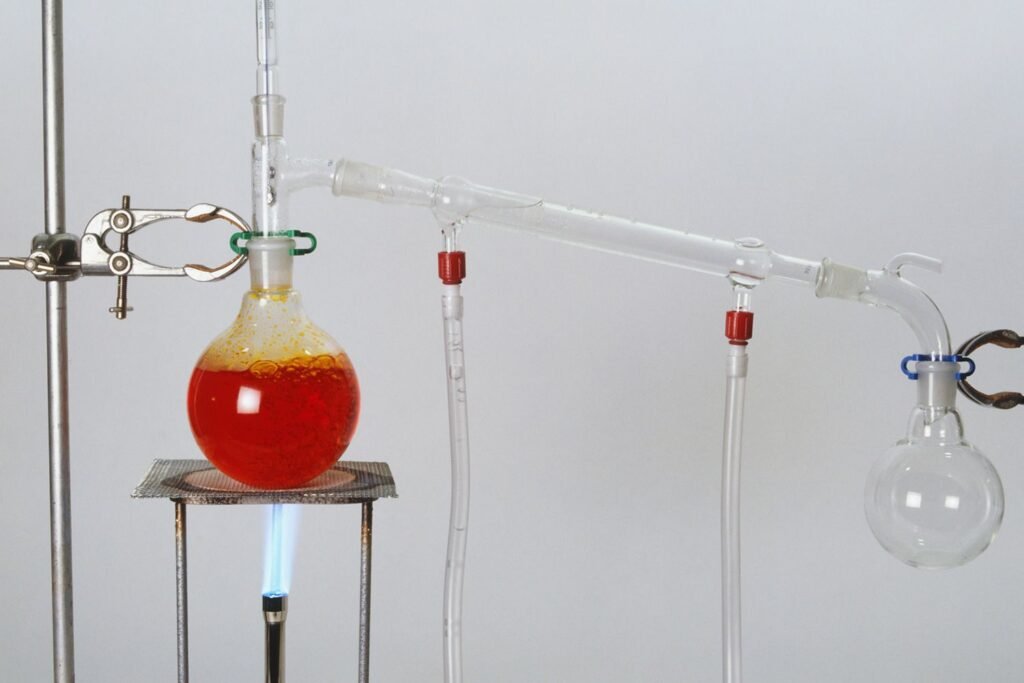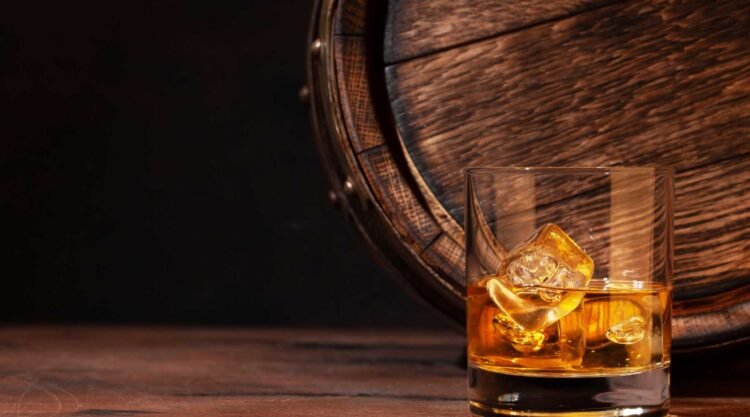Distillation is one of the most fundamental processes in the creation of spirits such as whiskey, vodka, gin, rum, and other grain-based liquors. The distillation process shapes the flavor and character of these spirits in profound ways, influencing everything from the smoothness of vodka to the rich complexity of aged whiskey. Understanding how distillation works, how different methods and equipment affect the end product, and how aging contributes to flavor development can deepen our appreciation for the art of spirit-making.
In this article, we will explore the intricate relationship between distillation and the flavor of spirits. We will examine how distillation works, discuss the impact of different distillation methods, and highlight how aging and maturation contribute to the overall flavor profile of spirits.
The Distillation Process: Transforming Liquid into Spirit
At its core, distillation is the process of separating alcohol from water and other impurities in a fermented liquid. It works on the principle of heating the liquid to evaporate the alcohol, which is then condensed back into liquid form. This allows for the separation of alcohol from water and other compounds that may alter the flavor of the final product. Distillation is what gives spirits their higher alcohol content, creating a more potent and concentrated product compared to the original fermented liquid.
1. Fermentation: The First Step
Before distillation can occur, fermentation must take place. During fermentation, yeast converts the sugars in the raw ingredients (grains, fruits, or other sugar-rich sources) into alcohol. The resulting liquid, known as “wash” or “mash,” is typically a beer-like liquid with low alcohol content. This fermented liquid contains alcohol, water, and a host of other compounds, including esters, acids, and fusel oils, that contribute to the spirit’s flavor.
2. Heating and Evaporation: The Beginning of Distillation
Once fermentation is complete, the next step is to heat the fermented liquid in a distillation still. A still is a specialized piece of equipment designed to heat the liquid, causing the alcohol to evaporate. Since alcohol has a lower boiling point than water (around 173°F or 78°C compared to water’s 212°F or 100°C), the alcohol evaporates first. The vapors are then captured and directed into a cooling system, where they condense back into liquid form.
The separation of alcohol from water and other impurities is crucial to the distillation process, and it is here that the flavor profile of the spirit begins to take shape. However, the quality of the distillation, the types of stills used, and the number of distillation runs can all significantly influence the final product.
How Different Distillation Methods Affect Flavor
Distillation can be performed using various methods, and each has a distinct impact on the flavor of the final spirit. Let’s explore some of the key methods of distillation and how they affect the flavor of grain spirits.
1. Pot Distillation: Traditional and Full of Character
Pot distillation is one of the oldest and most traditional forms of distillation, and it is still widely used for making high-quality spirits such as Scotch whisky, rum, and some gins. In pot distillation, the wash or mash is placed in a large, open pot still and heated directly over a flame or fire. As the alcohol evaporates, it rises through the neck of the still and condenses in a separate cooling chamber.
Pot distillation allows for the retention of more of the original flavors from the wash, which results in a more flavorful and characterful spirit. Pot stills often produce spirits with a heavier, richer body, which is particularly noticeable in aged whiskies and rum. However, pot distillation also tends to be less efficient than other methods, and it typically requires multiple distillation runs to achieve the desired purity and alcohol content.
2. Column Distillation: Efficient and Smooth
Column distillation, also known as continuous distillation, uses a tall, vertical column (or “tower”) to distill alcohol in a more efficient manner than pot stills. In this process, the wash is fed into the column, where it is continuously heated. The column is divided into different sections, each of which serves to further refine and purify the alcohol as it rises through the tower.
Column distillation is typically used for making spirits like vodka and gin, as it produces a highly purified, smooth, and clean spirit. The efficiency of column distillation allows for the separation of undesirable flavors and impurities, resulting in a lighter and more neutral flavor profile. For this reason, vodka and gin made through column distillation tend to have a clean, crisp taste with fewer complex flavors compared to pot-distilled spirits.
While column distillation does remove many of the flavorful compounds from the wash, it allows for greater control over the final product, making it ideal for spirits where the focus is on purity and versatility.
3. Hybrid Distillation: Combining the Best of Both Worlds
Some distillers use a combination of pot and column distillation in what is called hybrid distillation. This method allows for the retention of flavor from the pot still while also taking advantage of the efficiency and purity of column distillation. Hybrid distillation can be used for a wide range of spirits, allowing distillers to strike a balance between flavor complexity and smoothness.
Hybrid distillation is especially common in the production of craft spirits like artisanal gin and whiskey, where distillers aim to create a unique flavor profile by blending the two techniques. The hybrid approach allows for a more nuanced spirit that retains some of the earthy, complex characteristics of pot distillation while benefiting from the cleaner, smoother finish of column distillation.
4. Vacuum Distillation: A Modern Innovation
Vacuum distillation is a relatively modern technique that involves distilling alcohol under reduced pressure. By lowering the pressure inside the still, vacuum distillation reduces the boiling point of the alcohol and other volatile compounds. This allows the distillation process to take place at lower temperatures, which can preserve delicate flavors and aromas that might otherwise be lost at higher temperatures.
Vacuum distillation is particularly useful for producing high-end, aromatic spirits such as gin, where preserving the freshness of botanicals is key. The lower temperatures help retain the herbal, floral, and citrus notes that are characteristic of well-made gin. It also allows for the production of flavors that are more refined and complex, giving distillers the ability to create unique, high-quality spirits.

The Impact of Aging and Maturation on Flavor Development
While distillation is critical to shaping the initial flavor of a spirit, aging and maturation play an equally important role in flavor development. Aging allows spirits like whiskey, rum, and certain gins to develop additional complexity, smoothness, and richness over time. The aging process involves storing the distilled spirit in wooden barrels, typically oak, which allows the spirit to interact with the wood and absorb flavor compounds.
1. Whiskey Aging: Wood and Time Make the Difference
Whiskey is one of the most iconic spirits that benefits from aging. During the aging process, the whiskey absorbs flavors from the wood, which imparts notes of vanilla, caramel, oak, and spice to the spirit. The type of barrel used, whether it’s new charred oak or used barrels from wine or sherry, greatly influences the whiskey’s flavor profile.
As whiskey ages, it also undergoes a chemical transformation. The alcohol becomes smoother, and harsh, raw flavors mellow out, resulting in a more balanced and refined spirit. The aging process also allows the whiskey to develop more complexity, with flavors evolving over time. For example, a well-aged whiskey may have deep notes of dried fruit, tobacco, leather, and honey, whereas a younger whiskey may be more aggressive with notes of grain and spice.
2. Rum Aging: The Sweetness of Time
Rum, like whiskey, is also aged in wooden barrels, which enhances its flavor. The aging process in rum tends to produce flavors of caramel, brown sugar, and tropical fruits, as well as woodsy, spicy undertones. The climate in which the rum is aged also plays a significant role in its flavor development—rum aged in warmer climates tends to mature faster than rum aged in cooler climates.
Unlike whiskey, rum is often aged in both new oak barrels and previously used barrels that may have contained other liquids, such as sherry, wine, or bourbon. This interaction with different types of wood can impart unique flavors to the rum, making aged rum a fascinating spirit to explore.
3. Gin Maturation: A Rare and Special Process
Gin is typically not aged in the traditional sense, as its appeal lies in its fresh and aromatic qualities. However, some gins are aged for a short period in oak barrels, giving them a unique twist. Aged gin takes on subtle wood flavors that complement the botanicals, resulting in a more complex and rounded profile. While not as common as aged whiskey or rum, aged gin is gaining popularity in the craft spirits world, with distillers experimenting with different maturation techniques.
4. The Effects of Climate on Aging
The climate where the aging process occurs also has a significant impact on the flavor development of spirits. In warmer climates, like those in the Caribbean or southern United States, spirits tend to mature more quickly due to the higher temperatures, which accelerate the interaction between the spirit and the wood. In cooler climates, such as Scotland or Canada, the aging process tends to be slower, allowing for a more gradual development of flavor. The varying temperatures and humidity levels can lead to differences in the character of the final spirit.
Conclusion
Distillation is at the heart of spirit-making, and its influence on flavor development is profound. The method of distillation, whether pot distillation, column distillation, or hybrid distillation, shapes the purity, smoothness, and complexity of the spirit. The distillation process acts as the foundation for the flavor profile, determining how much character the final product will have.
However, distillation is just one part of the equation. Aging and maturation processes play an equally important role in refining and enhancing the flavor of spirits. Whether through the smooth oak flavors in whiskey or the tropical notes in rum, aging allows spirits to evolve into more complex and enjoyable beverages.
As you explore the world of spirits, remember that both the distillation process and the aging process are integral to creating the diverse flavors we enjoy. The next time you sip a glass of your favorite whiskey or gin, take a moment to consider how the art of distilling and aging shaped its flavor.































